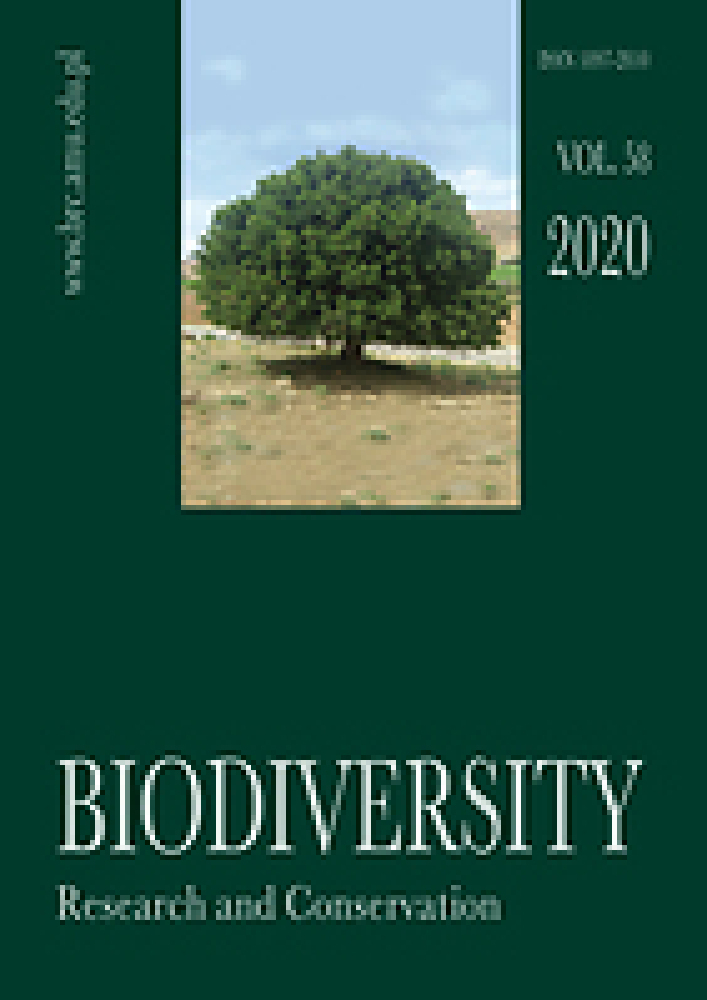Abstract
This study aims to investigate the coastal plant biodiversity status of Tripoli Province. The result of the survey led to a collection and identification of 130 plant species belonging to 36 families and 105 genera, of which 29 species represented monocotyledons and 101 dicotyledons. Floristic analysis revealed the dominance of the family Asteraceae (24 species) followed by the family Poaceae (22 species). The results have also showed the predominance of the genera Juncus and Lotus with 4 species each. Life form and chorological spectra analyses showed the prevalence of therophytes, represented by 77 species, and the Mediterranean chorotypes with 46 species. Categorization of collected plant species according to their ecological types, revealed a variety of ecological types, with the prevalence of psammophytes, represented by 50 species.
References
Altay V., Ozyigit I. I. & Yarci C. 2010. Urban flora and ecological characteristics of the Kartal District (Istanbul): A contribution to urban ecology in Turkey. Sci Res Essays 5(2): 183-200.
Altay V. & Ozturk M. 2012. Land Degradation and Halophytic Plant Diversity of Milleyha Wetland Ecosystem (Samandağ-Hatay), Turkey. Pak J Bot 44: 37-50.
Asaadi A. M. 2009. Floristic study of Firuzeh Watershed (North Khorasan province). Research Journal of Biological Science 4(10): 1092-1103.
Bartel S. D. & Sunkar R. 2005. Drought and salt tolerance in plants. Crit Rev Plant Sci 24: 23-58.
Choukr-Allah R. 1991. The use of halophytes for the agricultural development of south of Morocco. In: Choukr-Allah (ed.). Plant Salinity Research new Challenges, pp. 377-387. Agadir, Morocco, Institut Agronomique et Vétérinaire.
Davis P. H. 1962-1982. Flora of Turkey & the East Aegean Islands, vol. 1-9. University of Edinburgh. Edinburgh University Press.
El-Magsodi M. O. & Haddoud D. A. 2010. Tasks for Vegetation Science Series (Sabkha Ecosystems), vol. 46, pp. 79-84.
Environmental General Authority (EGA) 2010. The Fourth National Report on the Implementation of the Convention of Biological Diversity.
Feinbrun-Dothan N. 1986. Flora Palaestina. The Israel Academy of Science and Humanities. Jerusalem, vol. 4.
Flowers T. J. & Colmer T. D. 2008. Salinity Tolerance In Halophytes. New Phytol 179: 945-963
Govaerts R., Frodin D. G. & Radcliffe-Smith A. 2000. World Checklist and Bibliography of Euphorbiaceae (with Pandanaceae). Vol. 1. The Royal Botanic Gardens, Kew.
Grigore M. N., Toma C. & Boşcaiu M. 2010. Ecological Implications of Bulliform Cells on Halophytes, In Salt and Water Stress Natural Conditions. Analele Ştiinţifice Ale Universităţii “Al. I. Cuza” IaŞi Tomul Lvi, Fasc. 2, S. Ii A. Biologie Vegetală.
Grigore N. & Toma C. 2014. Integrative Ecological Notes on Halophytes from “Valea Ilenei” (Iaşi) Nature Reserve. Memoirs of the Scientific Sections of the Romanian Academy Tome xxxvii.
Guvensen A., Gork G., Ozturk M. 2006. An overview of the halophytes in Turkey. In: M. A. Khan, B. Böer, G. S. Kust & H. J. Barth (eds.). Sabkha Ecosystems. Tasks for Vegetation Science, vol. 42, pp. 9-30. Springer, Dordrecht. https://doi.org/10.1007/978-1-4020-5072-5_2
Jafri S. M. & El-Gadi A. A. 1977-1989. Flora of Libya. Al Faateh University. Faculty of Sciences. Department of Botany, Tripoli, Libya.
Kikli A. R. & Erteeb F. 2008. Floristic and Ecological Study of Farwa Island. M.Sc. Thesis, Department of Science and Environmental Engineering, Academy of Graduate Studies. Tripoli. Libya.
Mahklouf M. H. & Etayeb K. 2019. Biodiversity in Libya. In: T. Pullaiah (ed.). Global Biodiversity. Vol. 3: Selected Countries in Africa, pp. 113-133. New York, Apple Academic Press. https://doi.org/10.1201/9780429469800
Mahklouf M. H. Sherif A. & Betelmal A. 2018. Study of the Flora of Tarhuna. Tripoli-Libya. Hacettepe J. Biol. & Chem. 46:(3). 337-364. DOI: 10.15671/HJBC.2018.242.
Mahklouf M. H. & Al-Sghair F. G. 2016. Floristic and Inventory Study of Mallaha Wetland Tripoli, Libya. American Journal of Life Science Researches 4(4): 119-123.
Mittler R. 2006. Abiotic stress, the field environment and stress combination. Trends in Plant Sci. 11(1): 15-19
Moutterde P. 1966, 1970, 1983. Nouvelle Flore de Liban et de La Syrie. Dar el-Machreque, Beirut. Tome I, II, III.
Osma E., Ozyigit I., Altay V. & Serin M. 2010. Urban vascular flora and ecological characteristics of Kadıköy district, Istanbul, Turkey. Maejo Int J Sci Technol 4(01): 1-24.
Ozturk M. & Guvensen A. 2002. Studies on the Halophytic Vegetation of Saline-Alkaline Habitats in West Anatolia-Turkey. International Symposium on Optimum Resources Utilization in Salt-Effected Ecosystems in Arid and Semiarid Regions, 8-11 April, Cairo-Egypt.
Ozturk M., Gucel S., Guvensen A., Kadis C. & Kounnamas C. 2011. Halophyte plant diversity, coastal habitat types and their conservation status in Cyprus. In: M. Ozturk, B. Böer, H.-J. Barth, S.-W. Breckle, M. Clüsener-Godt & M. A. Khan (eds.). Sabkha Ecosystems, vol. III, pp. 99-111. Africa and Southern Europe, Tasks for Vegetation Science 46, Springer.
Raunkiaer C. 1934. The Life Forms of Plants and Statistical Plant Geography. The Clarendon Press, Oxford.
Zohary M. 1966, 1972, 1978. Flora Palaestina. The Israel Academy of Science and Humanities. Jerusalem. Vol. 1, 2, 3.





